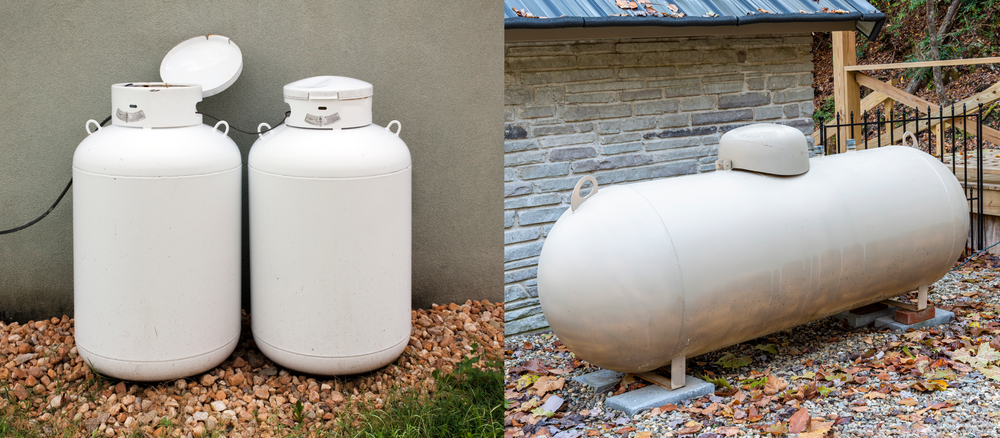Propane is an efficient, versatile fuel that powers various home appliances from stoves to heating systems. Choosing the correct propane tank size for your home is critical to ensure efficiency, cost-effectiveness, and safety. This comprehensive guide will help you understand the different sizes of residential propane tanks and their appropriate uses to ensure you select the optimal tank for your needs.
Why Propane?
Before diving into tank sizes, let's discuss why propane is a popular choice for residential use. Propane is known for its efficiency, burning cleaner than other fossil fuels, which can lead to lower utility bills and reduced environmental impact. Additionally, propane appliances are generally known for their longevity and performance. Learn more about switching to propane from other fuel sources like heating oil here.
Understanding Residential Propane Tank Sizes
Residential propane tanks come in a variety of sizes, each suited for different needs and usage levels. Here’s a breakdown of common sizes and what they're best used for in a residential setting.
1. 20-Pound Tanks
Typically known as grill tanks, 20-pound tanks are small, portable, and primarily used for barbecue grills and small patio heaters. These tanks are convenient for seasonal use and can easily be refilled at local supply stores or exchange locations.
2. 100-Pound Tanks
A 100-pound tank is a step up in size and capacity, suitable for running appliances like gas fireplaces, cooking ranges, or space heaters in small homes or seasonal cabins. These tanks are also used where the propane demand is intermittent or minimal.
3. 120-Gallon (420-pound) Tanks
This size tank is ideal for homes using propane for heating one or two small appliances. Common uses include supplementing a hot water heater or a stove. These tanks are usually sufficient for homes that don't rely heavily on propane but still need a steady supply.
4. 250-Gallon Tanks
A 250-gallon propane tank is typically used in homes that use propane for multiple appliances like water heating, cooking, and clothes drying. This size is recommended for households where propane is a primary source for either heating or hot water.
5. 500-Gallon Tanks
A 500-gallon tank is one of the most common sizes for residential propane usage. It's well-suited for larger homes that use propane as the primary source for central heating, water heating, and cooking. This tank size is also recommended if you live in a colder climate and rely heavily on propane for heating.
6. 1,000-Gallon Tanks
The largest commonly used residential tank, a 1,000-gallon tank, is best suited for very large homes or those with high propane needs. This might include homes with multiple heating systems, large water heating needs, or homes that also use propane for things like pool heating or spa heating.
How to Choose the Right Propane Tank Size
Selecting the right propane tank size depends on several factors including usage, the number of appliances being fueled, and expected fuel consumption. Here are some tips to help you make an informed decision:
1. Assess Your Needs
Calculate the total BTU (British Thermal Unit) requirements of all the appliances that will be using propane. This calculation can typically be found in the appliance's user manual and will guide the minimum capacity needed for efficient operation.
2. Consider Usage Frequency
How often you use your propane appliances impacts the size of the tank you might need. For intermittent use, like grilling, smaller tanks might suffice. For continual use, such as heating a home throughout the winter, larger tanks are more practical and economical.
3. Space and Location
The space available to install a propane tank and local regulations will also influence the size of the tank you can use. Larger tanks require more space and often specific clearances from buildings and property lines as dictated by local codes.
4. Future Needs
Consider potential future needs. If you plan on adding more propane appliances or expect to increase usage, opting for a larger tank now might save you from needing an upgrade later.
Choosing the right propane tank size is essential for efficient energy use and cost management. By understanding the different sizes and their intended uses, you can select a tank that not only meets your current needs but also accommodates future expansions. Always consult with a professional to ensure that your propane tank installation complies with local regulations and safety standards, and enjoy the benefits of this versatile fuel with confidence. Whether for residential warmth or commercial power, the right propane tank can make all the difference. Tankfarm makes buying and using propane easy, check here to see if they provide services in your area.




